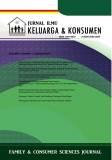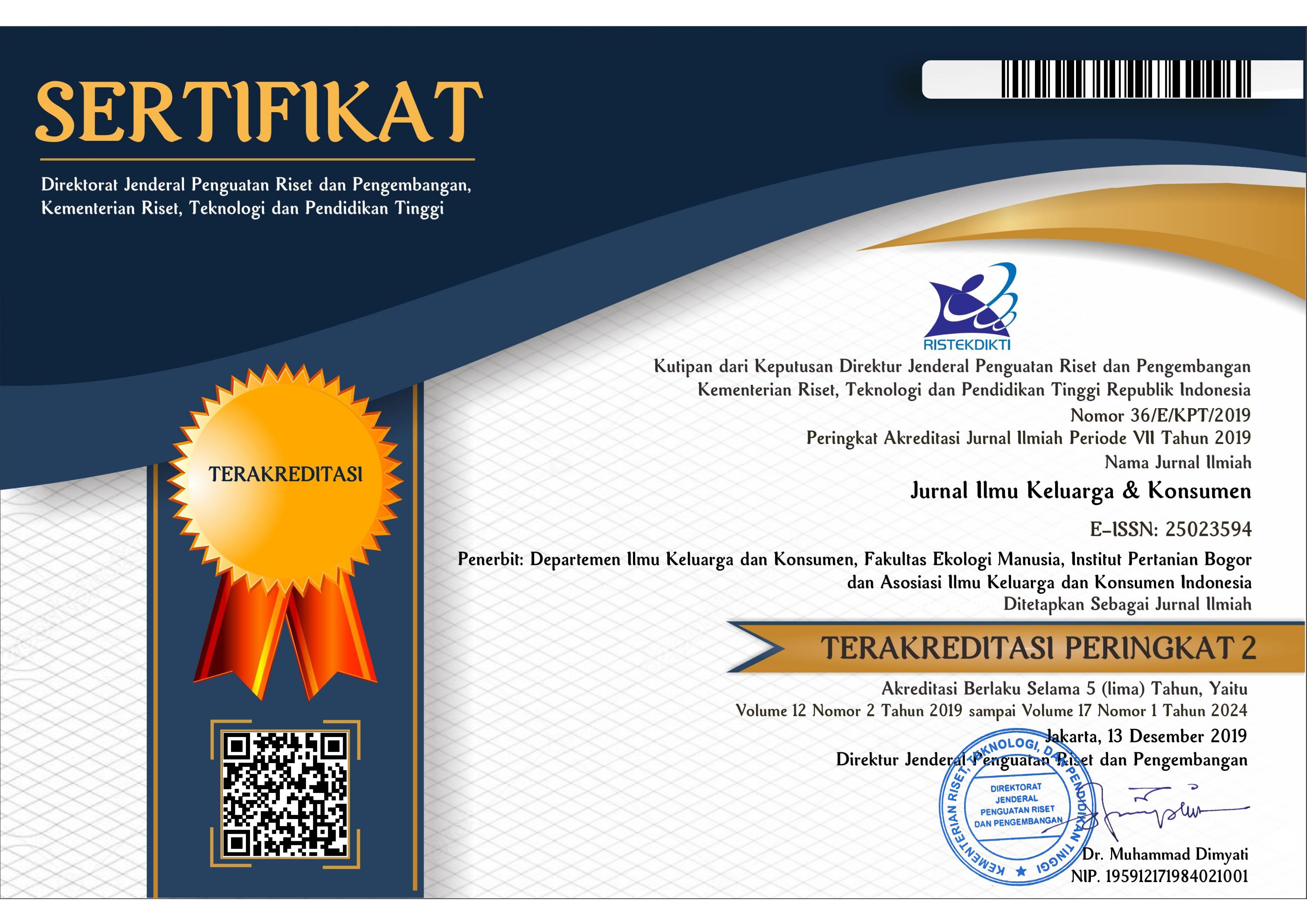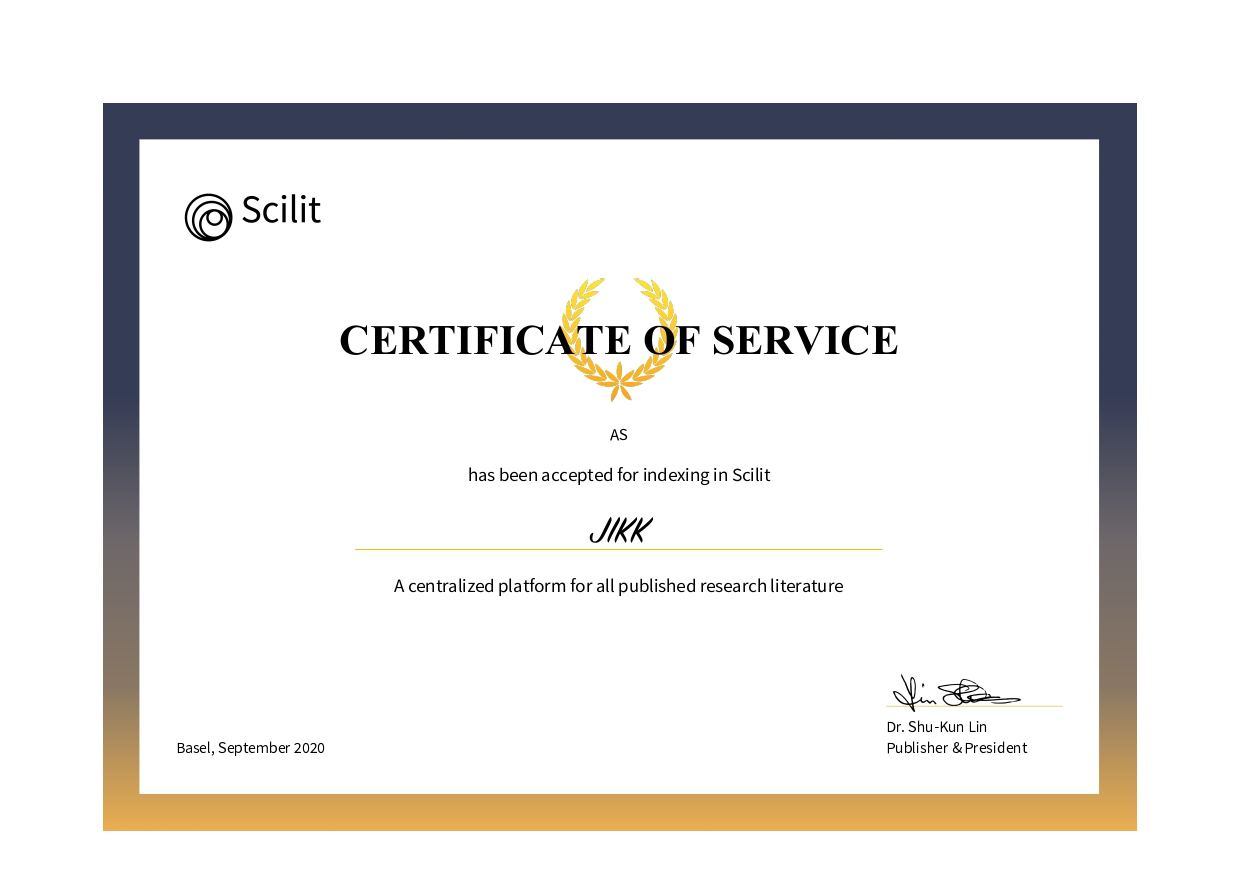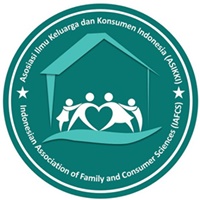Keberfungsian Agama di Keluarga, Ancaman, Interaksi Teman Sebaya, dan Religiusitas Remaja
Abstract
Religiosity has become one of significant factors in adolescence's development, which is influenced by the closest environment among others including religion function in family, threat, and interaction factors with peers. This research aims were analyzing influence adolescence's characteristics, mother's characteristics, religion function in family, threat, and peers interaction on adolescence's religiosity. This research used cross sectional study design on 240 students of class X having intact family and living with both of their parents. The respondents come from two senior high schools and two vocational schools (public and private) in Bogor that are selected purposively because of variation of social and economic status of the families. Data was processed using descriptive analysis and inferential analysis (independent simple t-test and regression test). The result shows that parents of vocational schools’ students had higher religion function. Boys had higher threats than girls. Private school students had higher interaction than public. Boys had higher religiosity than girls. Students of vocational school and private schools had higher religiosity than ones of senior high cchool and state school. Adolescent's age, religion function in family, and adolescents’s interaction with their peers had significant influence on the religiosity of adolescents. Meanwhile, adolescent's sex, age and mother's education did not have influence on the religiosity of adolescents.References
Alwi, S. (2014). Perkembangan Religiusitas Remaja. Yogyakarta (ID): Kaukaba Dipantara.
Anshari, E.S. (1987). Kuliah Al-Islam: Pendidikan Agama Islam di Perguruan Tinggi. Bandung (ID): Pustaka.
Aprilia, N., Indrijati, H. (2014). Hubungan antara kecerdasan emosi dengan perilaku tawuran pada remaja laki-laki yang pernah terlibat tawuran di SMK 'B' Jakarta.Jurnal Psikologi Pendidikan dan Perkembangan, 3, 1-11.
Bahr, S.J., Maughan., Marcos, A.C., Li. (2014). Family, religiosity, and the risk of adolescent drug use.Journal of Marriage and Family, 60, 979-992.
Bliss, A. Ekmark, S.S., (2013). Gender differences in spirituality in persons in alcohol and drug dependence treatment. Routledge Taylor & Francis Group, 31, 25-37, DOI: 10.1080/07347324.2013.746625
Bryant, A.N. (2007). Gender Differences in spiritual development during the college years. Sex Roles, 56, 835–846, DOI 10.1007/s11199-007-9240-2
Bukowski, M.W., Hoza, B., & Boivin, M. (1994).Measuring friendship quality during pre and early adolescence: the development and pshycometric properties of the friendship qualities scale.Journal of Social and Personal Relationship, 11, 471-484.
Botchcovar, E., Marshall, I.H., Rocque, M., Posick, C. (2016). The importance of parenting in the development of self control in boys and girls: result from multinational study of youth. Journal of Criminal Justice, 43,133-141.
Borch, C., Hyde, A., Cillessen A.H.N. (2011). The role of attractiveness and aggression in high school popularity.Journal Social Psychologi of Education, 14, 23-39. DOI 10.1007/s11218-010-9131-1
Cheung, C., Yeung, J.W. (2011). Meta-analysis of relationships between religiosity and constructive and destructive behaviors among adolescents. Children and Youth Services Review. 33, 376–385
Dermawan. S., Sunarti, E., & Herawati, T. (2018).Internalisasi nilai kebaikan melalui fungsi keagamaan dan pengondisian lingkungan dan dampaknya terhadap karakter anak.Jurnal Ilmu Keluarga & Konsumen,10 (3):, 204-215, DOI: http: //dx.doi.org /10.24156 /jikk.2017.10.3.204
Desrotser, A., Kelley, B.S., & Miller, L. (2011). Parent and peer relationship and relational spirituality in adolescents and young adults. Psychology of Religion and Spirituality, 3, 39-54. doi:10.1037/a0020037
Fergus, S., Zimmerman.M.A. (2005). Adolescent resilience: a framework for understanding healthy development in the face of risk. Annual Review of Public Health,26, 399-419.
Furrow, J.L., King, P.E., White, K. (2004) Religion and positive youth development: identity, meaning, and prosocial concerns. Developmental Science, 8, 17-26, DOI: 10.1207/S1532480XADS0801_3
Glock, C.Y., & Stark. R, (1968).American piety, patterns of religious commitment. Diambil dari www.books.google.com
Hackett, C., Murphy, C., & Mc Clendon, D. (2016).The gender gap in religion around the world. Washington DC: Pew Research Center
Holder, M.D., Coleman, B., Krupa, T., & Krupa, E (2015). Well being’s relation to religiosity and spirituality in children and adolescents in Zambia. Journal Happiness Study.DOI 10.1007/s10902-015-9640-x
Hurlock, E.B. (1993). Psikologi Perkembangan. Jakarta: Penerbit Erlangga
Junaidi, K. (2017). Pemberdayaan nilai-nilai institusi dan holistik education; kajian kontribusi pemimpin pendidikan terhadap gerakan revolusi mental.Jurnal Studi Kependidikan dan Keislaman, 07, 1-12.
Kaplan. (1999). Child and adolescent abuse and neglect research: a review of the past 10 years. Part I: Physical and emotional abuse and neglect. J. AM . Acad. Child Adolesc Psychiatry, 38, 1214-1222.
King, E. P., & Mueller, R.A. (2003). Parental influence on adolescent religiousness: exploring the roles of spiritual modeling and spiritual capital. Marriage and Family: AChristian Journal. 6 :401–13.
Kirsi, T., Nokelainen, & Ubani, M. (2006). Conceptual definition and empirical validation of the spiritual sensitivity scale. Journal for Empirical Theology, 19, 37–62.
Leonard, K.C., Boyatzis, C.J., Cook, K.V., Kimball, C.N., Flanagan, K.S. (2013). Parent-child dynamics and emerging adult religiosity: attachment, parental beliefs, and faith support. Journal Psychology of Religion and Spirituality. 5, 5–14. DOI: 10.1037/a0029404
Mukama. (2010). Peer group influence, alcohol consumption, and secondary school student attitudes towards school. (Disertation), Makerere University, Kampala, Uganda.
Najam, N., & Batool, S. (2016). Relationship between perceived parenting style, perceived Parental Acceptance Rejection (PAR) and perception of God among young adults.Journal of Behavioural Sciences, 22, 83-99.
Nisfiannoor, M., & Kartika, Y. (2004). Hubungan antara regulasi emosi dan penerimaan kelompok teman sebaya pada remaja. Jurnal Psikologi,2, 160-178.
Petts, R.J. (2014). Parental religiosity and youth religiosity: variations by family structure. Journal Sociology of Religion, 76, 95-120. doi:10.1093/socrel/sru064
Puspitasari, R., Hastuti, D., & Herawati, T. (2016). Pengaruh kecerdasan spiritual ibu terhadap karakter anak usia sekolah dasar di perdesaan. Jurnal Ilmu Keluarga dan Konsumen, 9 (2) : 101-112
Rose, A.J., Smith, R,L., Glick, G.C., & Mette, R.A. (2016). Girls’ and boys’ problem talk: implications for emotional closeness in friendships. Journal Developmental Psychology, 52, 629 – 639.
Santrock, J.W. (2007). Remaja.Jakarta: Penerbit Erlangga.
Sayidani, A., Irianto, W.S., Fuady, M.J. (2016). Perbandingan prestasi belajar mahasiswa lulusan SMA dan SMK pada prodi S1 pendidikan teknik informatika Universitas Negeri Malang. Jurnal Teknologi dan Kejuruan, 39, 155-162
Sub Direktorat Statistika Pendidikan dan Kesejahteraan Sosial. (2017). Statistik Pemuda Indonesia 2017. Jakarta: Badan Pusat Statistik.
Sunarti, E., Rochimah, N., & Islamia, I. (2015). Laporan Kajian Resiliensi Anak: Potret, Faktor Rumusan Aksi Penguatannya. Jakarta (ID): Kementerian Pemberdayaan Perempuan dan Perlindungan Anak Republik Indonesia.
Sunarti, E., Rochimah, N., Islamia, I., Ulfa, M. (2017). Pengaruh faktor ekologi terhadap resiliensi remaja. Jurnal Ilmu Keluarga dan Konsumen,10, 107-119. DOI: doi.org/10.24156/jikk.2017.10.2.107
Smith, C, & Denton. (2005). Soul Searching: The Religious And Spiritual Lives Of American Teenagers. Oxford University Press, USA.
Schwartz, S.H. (2006). Basic human values: theory, measurment, and applications. Revue Francaise de Sociologi, 47, 981-985.
Tasqiya, R. S., Hastuti, D., & Puspitawati, H. (2018). Spiritual parenting: the difference between father and mother, and their influence on spiritual intelligence. Proceeding : The 1st International Seminar on Family and Consumer Issues in Asia (ISFCI) “ Challenging family in Asia: Present and Future”, Bogor, 4th September 2018, 108-113
Vermeer, P. (2014). Religion and family life: an overview of current research and suggestions for future research. Journal Religions, 5, 402–421. doi:10.3390/rel5020402.
Walker, L.J., Hennig, K.H., Krettenauer, T.(2000). Parent and peer contexts for children’s moral reasoning development. Journal Child Development, 71, 1033–1048.
Wardhani, R., Sunarti, E., & Muflikhati, I. (2017). Ancaman, faktor protektif, aktifitas, dan resiliensi remaja. Jurnal Ilmu Keluarga& Konsumen, 10(1): 47-58.
Widianti, E. (2011). Pengaruh terapi logo dan terapi suportif kelompok terhadap ansietas remaja di rumah tahanan dan lembaga pemasyarakatan wilayah Provinsi Jawa Barat. (Tesis), Universitas Indonesia, Depok, Indonesia.
Zahra, N , Suherman, A , Permana, T. (2017). Pengaruh penerapan model pembelajaran kooperatif tipe student teams achievement division terhadap aktivitas, interaksi dan hasil belajar siswa SMK. Journal of Mechanical Engineering Education, 4, 213-218.
Zolkoski, S.M., Bullock, L.M.(2012). Resilience in children and youth: a review. Children and Youth Services Review, 34, 2295–2303. doi.org/10.1016/j.childyouth.2012.08.009.
Copyright (c) 2019 Jurnal Ilmu Keluarga & Konsumen

This work is licensed under a Creative Commons Attribution-ShareAlike 4.0 International License.
Authors submitting manuscripts should understand and agree that copyright of manuscripts published are held Jurnal Ilmu Keluarga dan Konsumen. The statement to release the copyright to Jurnal Ilmu Keluarga dan Konsumen is stated in Copyright Release Form. Copyright encompass exclusive rights to reproduce, to distribute, and to sell any part of the journal articles in all form and media. The reproduction of any part of this journal is allowed with a written permission from Jurnal Ilmu Keluarga dan Konsumen.










